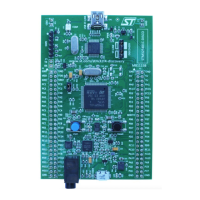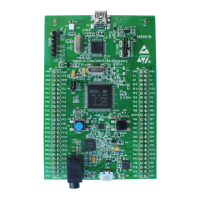CRC calculation unit RM0402
82/1163 RM0402 Rev 6
4 CRC calculation unit
4.1 CRC introduction
The CRC (cyclic redundancy check) calculation unit is used to get a CRC code from a 32-bit
data word and a fixed generator polynomial.
Among other applications, CRC-based techniques are used to verify data transmission or
storage integrity. In the scope of the EN/IEC 60335-1 standard, they offer a way of verifying
the Flash memory integrity. The CRC calculation unit helps compute a signature of the
software during runtime, to be compared with a reference signature generated at link-time
and stored at a given memory location.
4.2 CRC main features
• Uses CRC-32 (Ethernet) polynomial: 0x4C11DB7
–X
32
+ X
26
+ X
23
+ X
22
+ X
16
+ X
12
+ X
11
+ X
10
+X
8
+ X
7
+ X
5
+ X
4
+ X
2
+ X +1
• Single input/output 32-bit data register
• CRC computation done in four AHB clock cycles (HCLK)
• General-purpose 8-bit register (can be used for temporary storage)
The block diagram is shown in Figure 7.
Figure 7. CRC calculation unit block diagram
4.3 CRC functional description
The CRC calculation unit mainly consists of a single 32-bit data register, which:
• is used as an input register to enter new data in the CRC calculator (when writing into
the register)
• holds the result of the previous CRC calculation (when reading the register)
AHB bus
32-bit (read access)
Data register (output)
CRC computation (polynomial: 0x4C11DB7)
32-bit (write access)
Data register (input)
ai14968

